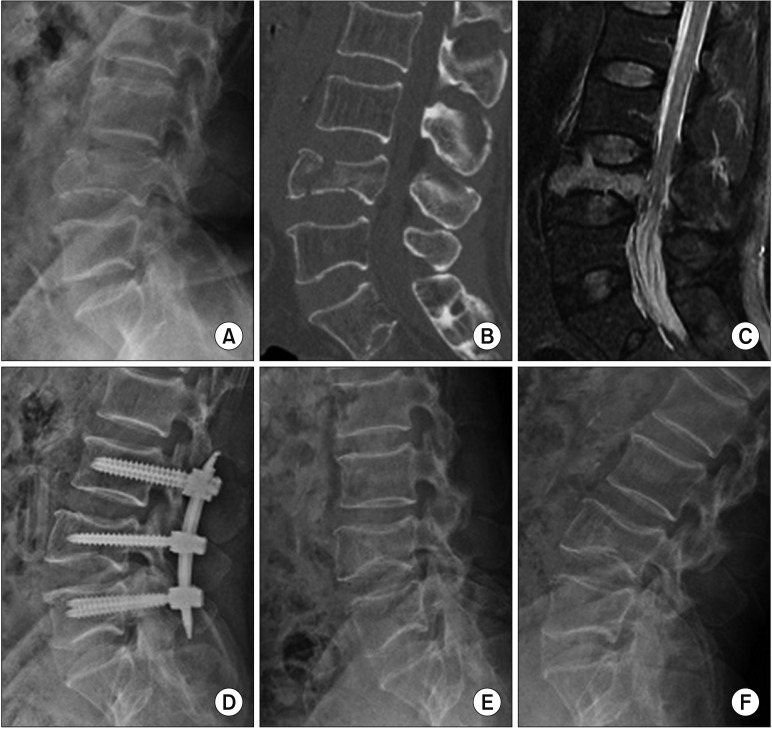Clin Orthop Surg.
2019 Sep;11(3):291-296. 10.4055/cios.2019.11.3.291.
Percutaneous Pedicle Screw Fixation in Thoracolumbar Fractures: Comparison of Results According to Implant Removal Time
- Affiliations
-
- 1Department of Orthopedic Surgery, Chonnam National University Hospital, Gwangju, Korea. hyseo2001@daum.net
- KMID: 2462557
- DOI: http://doi.org/10.4055/cios.2019.11.3.291
Abstract
- BACKGROUND
The purpose of this study was to determine whether restoration of range of motion (ROM) could be achieved by implant removal after natural bone healing and consolidation of fractured vertebrae and examine whether early removal of the implant could maximize restoration of ROM.
METHODS
This study included 30 cases of thoracolumbar fractures without neurological deficit requiring surgery (nine cases of flexion-distraction injuries and 21 cases of burst fractures). Percutaneous pedicle screw fixation (PPSF) was performed at the fractured vertebrae and one level above and one level below the fracture level. Pedicle screws were removed at an average of 12 months after surgery upon healing of fractured vertebrae. The following radiological and clinical findings were evaluated: restoration of anterior vertebral height ratio (AVHR), Cobb angle (CA), ROM, and complications. Sixteen patients who were checked for ROM were divided into two groups based on the time of implant removal: nine patients within 12 months and seven patients after 12 months. Restoration of vertebral height loss and ROM were compared between the two groups.
RESULTS
At the final follow-up, significant pain relief and restoration of AVHR and CA were achieved in patients who underwent PPSF. Patients who had implant removed within 12 months after surgery had better ROM recovery than those who had implant removed after 12 months postoperatively. There were no significant differences in AVHR and CA between the two groups.
CONCLUSIONS
PPSF followed by implant removal after healing of fractured body appears to be effective in achieving restoration of ROM. In our study, early removal of implant within 12 months after surgery was associated with better achievement of ROM than removal after 12 months. In addition, there were no significant differences in restoration of vertebral height between the two groups.
MeSH Terms
Figure
Cited by 1 articles
-
Comparison of Percutaneous versus Open Pedicle Screw Fixation for Treating Unstable Thoracolumbar Fractures
Jin Young Han, Ki Youn Kwon
J Korean Fract Soc. 2019;33(1):1-8. doi: 10.12671/jkfs.2019.33.1.1.
Reference
-
1. Fu Z, Zhang X, Shi Y, Dong Q. Comparison of surgical outcomes between short-segment open and percutaneous pedicle screw fixation techniques for thoracolumbar fractures. Med Sci Monit. 2016; 22:3177–3185. PMID: 27602557.
Article2. McLain RF, Sparling E, Benson DR. Early failure of short-segment pedicle instrumentation for thoracolumbar fractures: a preliminary report. J Bone Joint Surg Am. 1993; 75(2):162–167. PMID: 8423176.
Article3. Butt MF, Farooq M, Mir B, Dhar AS, Hussain A, Mumtaz M. Management of unstable thoracolumbar spinal injuries by posterior short segment spinal fixation. Int Orthop. 2007; 31(2):259–264. PMID: 16783550.4. Li K, Li Z, Ren X, et al. Effect of the percutaneous pedicle screw fixation at the fractured vertebra on the treatment of thoracolumbar fractures. Int Orthop. 2016; 40(6):1103–1110. PMID: 26983411.
Article5. Weber BR, Grob D, Dvorak J, Muntener M. Posterior surgical approach to the lumbar spine and its effect on the multifidus muscle. Spine (Phila Pa 1976). 1997; 22(15):1765–1772. PMID: 9259789.
Article6. Kramer M, Katzmaier P, Eisele R, Ebert V, Kinzl L, Hartwig E. Surface electromyography-verified muscular damage associated with the open dorsal approach to the lumbar spine. Eur Spine J. 2001; 10(5):414–420. PMID: 11718196.
Article7. Grossbach AJ, Dahdaleh NS, Abel TJ, Woods GD, Dlouhy BJ, Hitchon PW. Flexion-distraction injuries of the thoracolumbar spine: open fusion versus percutaneous pedicle screw fixation. Neurosurg Focus. 2013; 35(2):E2.
Article8. Kim HS, Kim SW, Ju CI, Wang HS, Lee SM, Kim DM. Implant removal after percutaneous short segment fixation for thoracolumbar burst fracture: does it preserve motion? J Korean Neurosurg Soc. 2014; 55(2):73–77. PMID: 24653799.9. Axelsson P, Stromqvist B. Can implant removal restore mobility after fracture of the thoracolumbar segment? Acta Orthop. 2016; 87(5):511–515. PMID: 27339484.
Article10. Chen JX, Xu DL, Sheng SR, et al. Risk factors of kyphosis recurrence after implant removal in thoracolumbar burst fractures following posterior short-segment fixation. Int Orthop. 2016; 40(6):1253–1260. PMID: 27116190.
Article11. Alanay A, Acaroglu E, Yazici M, Oznur A, Surat A. Short-segment pedicle instrumentation of thoracolumbar burst fractures: does transpedicular intracorporeal grafting prevent early failure? Spine (Phila Pa 1976). 2001; 26(2):213–217. PMID: 11154543.
- Full Text Links
- Actions
-
Cited
- CITED
-
- Close
- Share
- Similar articles
-
- Comparison of Percutaneous versus Open Pedicle Screw Fixation for Treating Unstable Thoracolumbar Fractures
- Short Segment versus Long Segment Pedicle Screws Fixation in Management of Thoracolumbar Burst Fractures: Meta-Analysis
- Bone Cement-Augmented Short Segment Fixation with Percutaneous Screws for Thoracolumbar Burst Fractures Accompanied by Severe Osteoporosis
- More Than 5 Year Follow-Up of Thoracolumbar Fractures Treated By Pedicle Screw Fixation
- Predictability of Magerl & McCormack's Load Sharing Classification on the Metal Failure after Pedicle Screw Fixation in the Thoracolumbar Spine Fracture



